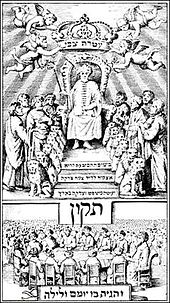Jewish schisms
This article needs additional citations for verification. (February 2023) |
| Part of a series on |
| Jews and Judaism |
|---|
Schisms among the Jews are cultural as well as religious. They have happened as a product of historical accident, geography, and theology.
Samaritans
The Samaritans are an ethnoreligious group of the Levant originating from the Israelites (or Hebrews) of the Ancient Near East.
Ancestrally, Samaritans claim descent from the
They consider themselves to be B'nei Yisrael ('Children of Israel'), a term used universally by Jewish denominations for the Jewish people as a whole, but do not call themselves Yehudim. The word Yehudim comes from the
First Temple period
The biblical narrative describes the split by the Kingdom of Israel from the Kingdom of Judah.[3] It points to Solomon's unfaithfulness to the divine covenant as the reason for the schism.[4] When Rehoboam, Solomon's son, became king, the people requested tax reform. Rehoboam refused. This caused the break. At first, Rehoboam considered a military solution but the prophet Shemaiah told him not fight because God had caused the schism. Jeroboam, the leader of the tax revolt, became the leader of the Kingdom of Israel.
After the destruction and exile of the Kingdom of Israel by
Second Temple period
Conflicts between
According to Josephus, the Sadducees differed from the Pharisees on a number of doctrinal grounds, notably rejecting ideas of life after death. They appear to have dominated the aristocracy and the temple, but their influence over the wider Jewish population was limited.
The Essenes preached a reclusive way of life. The Zealots advocated armed rebellion against any foreign power such as Rome. All were at violent loggerheads with each other, leading to the confusion and disunity that ended with the destruction of the Second Temple and the sacking of Jerusalem by Rome.
Split of early Christianity and Judaism

The first Christians (whom historians refer to as
The eventual repudiation of
Karaite Judaism

Karaite Judaism is a
Karaites had a wide following between the 9th and 12th centuries (they claim that at one time they numbered perhaps 10 percent of Jewry), but over the centuries their numbers have dwindled drastically. Today they are a small group, living mostly in Israel; estimates of the number of Israeli Karaites range from as low as 10,000 to as high as 50,000.[7][8][9][10]
There is a divergence of views about the historical origins of Karaite Judaism. Most scholars and some Karaites maintain that it was founded at least in part by Anan ben David, whereas other Karaites believe that they are not the historical disciples of Anan ben David at all, and point out that many of their later sages (such as Ya'acov Al-Kirkisani) argued that most of Anan's teachings were "derived from Rabbanite Lore".
The state of Israel, along with its Chief Rabbinate, ruled that Karaites are Jews, and while critical differences between Orthodox Judaism and Karaite Judaism exist, American Orthodox rabbis ruled that Karaism is much closer to Orthodoxy than the Conservative and Reform movements, which may ease issues of formal conversion.
Sabbateans and Frankists

In 1648
After his mysterious death somewhere in the area of
A few decades after Shabbatai Sevi's death, a man by the name of
Hasidim and Misnagdim

Israel ben Eliezer (1698–1760), also known as the
Baal Shem Tov witnessed Frank's public
Already during his lifetime, and gaining momentum following his death, Baal Shem Tov's disciples spread out to teach his mystical creeds all over Eastern Europe. Thus was born
Only when this new religious movement reached
The Vilna Gaon, who was himself steeped in both
Little of the split between Hasidim and Mitnagdim remains within the modern Haredi world.[
Orthodox versus Reform
From the time of the French Revolution of 1789, and the growth of Liberalism, added to the political and personal freedoms granted by Napoleon to the Jews of Europe, many Jews chose to abandon the foreboding and isolating ghettos and enter into general society. This influenced the internal conflicts about religion, culture, and politics of the Jews to this day.
Some Jews in
Thus a cultural
See also
- Apostasy in Judaism
- Culture of Israel
- Heresy in Judaism
- Jewish atheism
- Jewish religious movements
- Jewish secularism
- Jewish Science
- List of Israelite civil conflicts
- Reconstructionist Judaism
- Relationships between Jewish religious movements
- Religion in Israel
- Who is a Jew?
References
- ^ The Samaritan Update Retrieved 1 January 2017.
- ISBN 978-1-61117-410-6.
- ^ 1 Kings 12
- ^ 1 Kings 11
- ^ "History & Overview of the Dead Sea Scrolls". www.jewishvirtuallibrary.org.
- ^ This theory regarding the law and the birth of Christianity is not supported by the New Testament book of Acts. In Acts, the law becomes an issue after Christianity is already born by the events of Pentecost. See Acts 2.
- ^ Judaism, continued... from Adherents.com
- ^ Karaims of Israel Archived 2004-12-09 at the Wayback Machine
- ^ qumran.com Archived 2004-12-13 at the Wayback Machine
- ^ qumran.com Archived 2004-12-13 at the Wayback Machine
